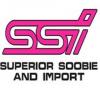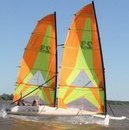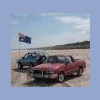Leaderboard
Popular Content
Showing content with the highest reputation on 11/21/22 in all areas
-
Looking great man, can't wait to see this thing yeet. Have you considered something like the holley hydramat for the fuel pickup? Would drastically increase the filter surface area and is supposed to help get every last drop out of the tank when it's close to empty. I understand they are kinda pricey though. Front subframe makes sense to be solid mounted because it has to carry the engine and provide strength between the frame rails in the engine compartment, since there's a big hole where the engine goes. Soft mounting the whole front subframe would mean those bushings would react loads from the steering rack, engine, and control arms all at once - not great for steering compliance, chassis feel, drivetrain alignment, etc. Solid mounting the front subframe lets the steering rack, control arms, and engine each be mounted with their own bushings that can be tuned for each component. Rear, the chassis is more whole above the rear subframe so there's less need for added strength/stiffness. The engineers would want some cushion/compliance for lateral loads for ride comfort, but they would want to prevent toe compliance so your rear wheels don't steer all over the place. If they had solid mounted the rear subframe and used softer bushings for the lateral links, then compliance in the lateral link bushings would cause the rear toe to vary with lateral load. Using stiffer bushings for the lateral links and (relatively) softer bushings for the subframe lets the system be comfortable but still keep toe in check since the subframe bushings can react moments across a wider distance. Rear subframe mount, my concern is that the bolts without bushings will induce more stress in the chassis at those points. If you have two solid mounts and four rubber mounts, the solid mounts will be doing almost all of the work. The rubber grommets sandwiching the subframe might help but probably won't do much for the lateral loads which would be the most impactful. IMO your best move would be to add an OEM-style rubber bushing to those middle bolts, but if you don't want to go through that trouble I'd say get rid of the rest of the rubber subframe bushings and hard mount the whole thing. That way lateral force can be shared by all six bolts instead of just two. I don't think any decrease in ride quality is much of a concern in this context haha, and it might make it easier to mount the gas tank skid plate.1 point
-
First, try to answer some questions. Thanks for posting that vid, shows some pretty good crawling although as always it seemed a lot steeper in person. This is how high above the rear fender lip the tire goes at full bump with no bumpstop. Angle of the photo makes it look like more but 1.25" + with very worn tread. I'd figure at least 1.75" with new 215/75/15 to be safe. I still think it will take a lot of structural cutting to make even bigger tires fit when they're pushed out a couple inches. Cutting/bending out the front fenders, sure no problem, but the rears will be a lot of fab work to get the body to seal I think. Possibly a bigger problem will be the front tires rubbing the firewall. As it sits there's maybe an inch of clearance. And I can tell you from experience once bushings wear out and things get a little tweaked the 215/75/15s rub on the firewall (back of the front wheel well). No idea how you'd solve that problem without a LOT of fab work. Whiteline does sell offset bushings for the aluminum rear brackets for the front control arms and I think I have a pair but that won't buy you a lot of clearance. Really not trying to hate, I think these cars would be even better with taller tires now that we have low ranges. Would be cool if you make it work just want to make sure you know what you're up against. I thought about welding the rear strut hole but figured it'd just be a lot of welding and grinding with minimal benefit. Painted those and thought I took pictures but don't have them handy. Yes, planning on removing those trailing arm spacers when we fab the new trailing arms. Less leverage on the mount, more up and back motion for ride quality, etc. Moving on - sleeved and capped the subframe spacers. Painted all the spacers with some brush on tractor enamel. Looks terrible but on the plus side you can put it on a lot thicker than spray paint, no overspray (nice in the winter), and it seems to hold up better. Front subframe spacer with bottom plate installed. Trans and driveshaft spacers installed. Unfortunately I couldn't quite get full droop in the front, the axles were hitting the arms. I'm not sure if the trans is effectively lower on this one than our other cars or if the auto trans outputs are a little lower. Regardless, some cutting, welding, and painting took place. Didn't take much, even this much gives me a decent amount of clearance. Might be able to get away with cutting a slot in that wall and just hammering the top down. Next on the fab and paint agenda was the steering column. Had to add 20mm / 0.8". Turned up a sleeve out of 300M and welded and painted it. Should figure out a better way to do this next time, despite a lot of spraying with WD40 the u joints might have lost some grease. Maybe submerge them in oil or water while welding. Last fab project before the test drive, welded some reservoir mounts on and moved the brake line brackets. Painted those, installed struts etc. Did install a bolt in the middle of the rear subframe mounts. Put rubber grommets above and below for some bushing effect. Interesting that it's rubber mounted (albeit stiffly) and the front is solidly mounted. Regardless, after getting sorta used to the black Outback, I'll be fine. One more long travel Subaru on the loose. White Outback for scale. Only weighs 2995#! 56% front weight now. Tires and suspension and spacers are heavier, wheels are lighter and we removed the front bumper cover, foglights, and swaybars. Will eventually be close to 4000# with the H6, bumpers, skidplates, cargo, and a couple people inside. Then it will sit lower and probably ride better, it's definitely a little stiff right now. For reference, my black Outback weighed 4152# the last time we weighed it (a couple years ago) with no people or cargo but with H6, bumpers, skidplates, etc. B also welded up the hatch latch (body side) in his blue Forester, it was all cracked and sloppy. We checked and tightened a few things on the front end too. Back to the black Outback. Replaced the LF wheel bearing, wasn't real sloppy but was making a ton of noise. Pictured below is our "fix" during our last trip for the fuel pickup getting clogged. See yellow ball valve on left. Open that up and blow into it hard to clear the pickup sock. Took the fill plate off. Gaskets were still in excellent shape, polyurethane I used last time works much better than the supposedly fuel resistant rubbers I'd tried before. Took some foam out and peeked in, nowhere near as bad as I expected. Foam doesn't seem to be disintegrating. Some small debris in the tank but not much considering the cell has been in there for perhaps 100k miles without being cleaned out. Pickup tube and sock was jammed in the corner, which is probably how it's always been, but by the time I got it out it was kinked a bit, not sure if that's how it was before I started removing it. Sock definitely has a lot of crud on it. Pretty sure it started out white. Removed the sock and put the pickup hose back in. Put a clear inline filter before the pump. We'd thought about doing this on the trip and bought the parts to do it but I didn't want to remove the pickup sock then. This is what it looked like after about a half hour of driving around town today. Need to swap it out, maybe backflush it and use again. Will probably do that a few times and then put a coarser screen pickup sock on the pickup tube and leave one of these in place.1 point
-
Thanks for the pointer to BAS and mentioning the tooling. PO had replaced the battery terminal on our Forester with the usual parts-store lead clamp - with the 1/2" nut - and that annoyed the crap out of me until I replaced it with a junkyard harness to restore it to 10mm.1 point
-
Yes, and take photos before you take it apart1 point
-
We prefer to replace the terminals with similar-to-stock (Subaru does not sell the negative terminal except as part of it's sub-harness): https://www.buyautosupply.com/products/k13101-toyota-gm-style-battery-terminal-kit-positive-negative.html We cut off the factory Subaru crimped negative and crimp/heat shrink a lug to the cable for use with these terminals from BAS. These retain the stock look and feel and 10mm tooling of the OEM terminals. Use of quality terminals, some form of protectant (grease, spray, etc), and NOT torqueing them till you break the plastic around the terminal and cause the battery to leak are key to success here. GD1 point
-
Geez! You’d think from a tooling perspective they’d make the carb heads the same as the EFI heads, then adapt the carb intake manifold to the heads as it’s a “custom” piece with the carb anyway - then there’s one gasket across many EJ engines! It wouldn’t greatly effect performance, I really don’t understand why they did that! Well spotted. You must be getting excited right about now! Cheers Bennie1 point
-
That's all structural and further limits the viability of the chassis for performance purposes. Go buy an STI if you have lots of money to burn and actually want results. Or buy a 4th gen Camaro with an LS1, or a Cadillac CTS-V, etc. Plenty of good budget performance options without throwing money at a Subaru..... but you go die on that sword if you must. Many have and many more will. GD1 point





